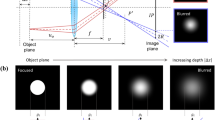Abstract
This article examines a new approach to high-precision dilatometry that employs interference measurements of elongation. The fact that visual information is read from the entire interference field makes the measurements more informative as a whole. The data that is obtained is analyzed in real time with the use of special software, which allows more accurate measurement of the position of the fringes and reduces the error of measurement of the coefficient of thermal expansion to 2·10–9 K–1.
Similar content being viewed by others
References
A. N. Amatuni et al., Elektron. Tekh., Ser. 5(147), 16 (1991).
I. M. Dremin, Usp. Fiz. Nauk, 170, No. 11, 1235 (2000).
J. Forsyte, M. Malcolm, and K. Mowler, Machine Methods of Mathematical Computation [Russian translation], Mir, Moscow (1980).
T. A. Kompan et al., Izmer. Tekh., No. 8, 38 (1999).
Rights and permissions
About this article
Cite this article
Kompan, T.A., Korenev, A.S. & Lukin, A.Y. Automated Dilatometric System Employing Multvariate Analysis of Interference Patterns. Measurement Techniques 44, 601–607 (2001). https://doi.org/10.1023/A:1012371314171
Issue Date:
DOI: https://doi.org/10.1023/A:1012371314171




